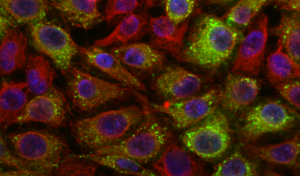Material properties of Biomolecular condensates, FlickerPRINT
 A growing area of interest in our group is the study of liquid liquid phase separation (LLPS) in biological systems, with a focus on stress granules. Stress granules are LLPS organelles consisting of RNA and RNA binding proteins formed dynamically in response to oxidative stress and dysregulation of stress granule dynamics is implicated in many ‘aggregation disorders’ including neurodegenerative disease.
A growing area of interest in our group is the study of liquid liquid phase separation (LLPS) in biological systems, with a focus on stress granules. Stress granules are LLPS organelles consisting of RNA and RNA binding proteins formed dynamically in response to oxidative stress and dysregulation of stress granule dynamics is implicated in many ‘aggregation disorders’ including neurodegenerative disease.
FlickerPRINT employs computational modelling and soft matter physics approaches to develop flicker spectroscopy (FS) to understand the material properties of these dynamic liquid droplet organelles and study how they are altered in ageing and neurodegenerative disease. FS measures the characteristic flicker or ‘wobble’ associated with a liquid droplet versus a more viscous droplet or gel, i.e. the ‘fingerprint’ of a healthy liquid condensate versus one tending towards pathological hardening, for example by comparing normal cells with those carrying ALS mutations, or young versus senescent cells. Our ambition is to be able to profile condensates based on their material properties and relate it to disease-specific changes in condensate profiles.
Read more about it in this article about the study of liquid liquid phase separation (LLPS).

 Current projects on alternative splicing regulation include studies in Ageing, Senescence, Retinitis Pigmentosa, Parkinsons and Breast Cancer. Using in-house RNA-seq data as well as from public repositories, we seek to gain a mechanistic understanding of how dysregulation of alternative splicing contributes to the ageing phenotype or disease pathology.
Current projects on alternative splicing regulation include studies in Ageing, Senescence, Retinitis Pigmentosa, Parkinsons and Breast Cancer. Using in-house RNA-seq data as well as from public repositories, we seek to gain a mechanistic understanding of how dysregulation of alternative splicing contributes to the ageing phenotype or disease pathology.